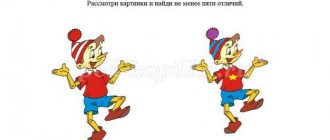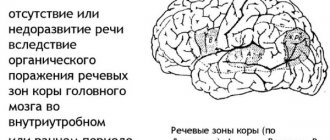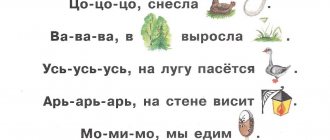Article:
Memory is the ability of our brain to store, process and organize received information.
Without memory, a person would not be able to accumulate knowledge and evolve. Many details are stored in the mind every day so that in the future it will be easier for us to make decisions, find a way out of unusual situations, and improve living conditions. There is an opinion that the Internet replaces memory: why fill your head with unnecessary facts from childhood if you can find anything in a couple of seconds? It turns out that not everything is so simple. Memory includes reflected experience, which shapes reactions, values, and cognitive abilities. You need to develop the necessary skills from childhood. We share effective exercises for developing memory in preschool children that are easy to perform at home.
Types of memory
Let's figure out what types of memory exist. Typically, psychologists use several classifications depending on the main feature that characterizes the memorization process.
By information storage period
- Short-term . Quick, mechanical memorization of small pieces of information for a short period of time. The amount of such memory is small. People use it when they need to learn a phone number, address, password, dates.
- Operational . It is similar to short-term, but is used during mental processes: for example, when solving an arithmetic example orally, a person is forced to remember intermediate results.
- Long-term . Deep, thorough memorization of important details that can have an impact on life. This is an extensive system of knowledge interconnected. We select the most important fragments from short-term memory and, through an effort of will, move them to long-term memory.
By type of perception
- Visual . Willingness to retain and, if necessary, reproduce visual symbols (memory for faces, colors).
- Auditory . A type of sensory memory that allows you to store sound images and impressions.
- Motor (muscular) . Memorizing and reproducing movements (dancing, drawing, driving). Helps develop coordination.
- Emotional . A type of memory that intensifies with shock, a surge of feelings (surprise, anger). What is remembered first is not the facts, but the sensations.
By participation of will
- Free _ Requires concentration: the brain sets a task, purposefully concentrating on memorization (for example, while studying for an exam).
- Involuntary . In this case, there is no desire to remember information; it is stored in the head automatically. Involuntary memory works especially actively when we do something in practice or encounter an unusual, strange experience. Knowledge is also acquired independently if the topic is related to a person’s range of interests.
According to the form of information storage
- Figurative memory . The ability of the brain to collect fragments of sensory impressions, combine them and create images that refer to the necessary information.
- Verbal-logical . Language becomes the keeper of data, with its help the mental process of memorization occurs. Words, sentences, their internal logic are the basis of this type of memory.
By participation of thinking
- Mechanical . Thorough, step-by-step learning without the use of associations and personal impressions.
- Logical . The opposite of cramming: the main role is played not by the form, but by the meaning, which must be comprehended and the essence remembered. Only humans have this skill.
- Associative . Using already accumulated ideas to connect with new experiences.
Memory value up to 7 years
Scientists have developed many definitions for memory. But everyone recognizes that this is a complex mental process. Memory is the ability of a child and an adult to receive life experience, retain it and reproduce it.
The life experience of a preschooler includes everything that surrounds him, everything he encounters. Memory develops rapidly up to 7 years of age. This is the so-called natural memory.
A preschooler remembers when he sees an unfamiliar picture or object.
If he saw something out of the ordinary, he begins to talk, remembering something similar from his experience. The thinking of a small child consists of memory, of his life experience.
Therefore, as rich and varied the experience is, so full and strong will be his natural memory.
By the way, the speed of its development cannot be compared with the development of the child’s other abilities. She is the tallest. This is achieved through the ideal interaction of both hemispheres of the brain.
Why are children geniuses from birth? Because up to 3 they have this amazing synchronicity. And those adults who own it are considered geniuses.
What is the minimum you can do to be calm about your child’s future, read our book and get the most effective games.
For the most physiological method of development from birth, follow this link (will open in a new tab).
Features of memory in preschool children
A child's memory needs a special approach. Features of perception and memorization of information depend on the age period.
Preschoolers can be divided into several age groups.
- From 1 year to 2 years, the baby’s nervous system improves, and after 2 years, visual memory predominates. The first memories associated with visual factors arise.
- From 2 to 4 years old, a child works with mechanical memorization of details of the surrounding world, repeating words and actions after his parents. Motor memory also improves.
- From 4 to 6 years old, a preschooler begins to rely on involuntary memory based on personal impressions.
It is difficult for preschoolers and first graders to direct their willpower to memorize. Involuntary memory based on novelty dominates. Knowledge is best perceived by a child through direct contact with the teacher. One of the main tasks at this age is to improve voluntary, conscious memory.
Figurative and emotional memory become leading. Through these channels of perception, the child will learn the basics of mathematics, languages, and natural sciences. You cannot completely rely on emotional memory: in a stressful situation, children will not be able to reproduce acquired knowledge, because the sphere of feelings will be inhibited.
Teachers and parents should gradually introduce exercises into the lesson program to develop logical, figurative memory. This is exactly what adults have. However, you shouldn’t forget about other types either.
Auditory memory disorders
It happens that a child experiences difficulties in perceiving speech, when isolating it from the surrounding noise, cannot immediately understand tasks and commands received orally, when mastering new words or learning languages. These problems may not be related to attention deficits or lack of motivation, and may not be the result of bad behavior. Perhaps the reason lies in auditory neurological disorders. Disorders of auditory processing may be associated with traumatic brain injury, long-term inflammation of the middle ear, birth trauma, and other causes. In such cases, consultation with a specialist is necessary. Treatment, as a rule, includes several areas: improving cognitive and speech skills, improving the perception of auditory information, improving the quality of the auditory signal.
Games and exercises for developing memory in preschoolers
You can do memory development exercises at home. It is not necessary to allocate free time for classes - at first, the exercises are performed in conversation with the child, almost in passing.
Exercises to develop visual memory in children
- Show the pictures for 30 seconds, then cover them with a sheet of paper and ask the child to describe the depicted objects in detail: color, shape, location.
- The following exercise works well. Place the objects in a chaotic order and let them observe them. Then the child will have to turn away, and you will remove one detail. The baby’s task is to quickly name the missing object.
- Finding differences between images develops not only memory, but also attentiveness. Print or buy a book of puzzles that ask you to describe what has changed in the second picture compared to the first.
- Learn with your children important information that will be useful in a difficult life situation: house address, phone numbers of family members, last name and first name. Make a sign and put it in a visible place.
Exercises to develop auditory memory
- Read books out loud. After reading each chapter, the child should retell the content. Try to read with expression and emotion, so that events are remembered more easily.
- Learn poems by heart with your child. Parents often consider this activity useless, but at an early age it is critically important for the full development of the child. It is important to hear the rhythm of the piece and place the accents correctly.
- Ask again. What did the cartoon heroine say a second ago? What was the intonation? What did her friends say?
Games and exercises for the development of motor and tactile memory
- Pieces of fabric with different textures (linen, wool, silk) are laid out on the table. The child must touch them blindfolded and after a few minutes name the sequence in which they were located.
- Dancing. Gather the guys in a group and demonstrate dance movements, moving from simple to complex, combined. Then the children will repeat to the music what was demonstrated to them.
- Game with prohibited movements. Players repeat every action of the leader. The adult agrees with the children which movement cannot be repeated (for example, clapping). Whoever is inattentive is eliminated.
Exercises to develop associative memory
- To develop associative memory, an individual approach to the student will be required. It is advisable to form images based on personal memories. For example, when memorizing characters, remind your child of real life incidents. Are the heroes celebrating their birthday? Refresh your memory of the last party in honor of this holiday.
- The words for which the child selects epithets are written in a column (morning - fresh, early, autumn - golden). The exercise also enriches your vocabulary.
Exercises to develop emotional memory
- Reading literary dialogues by role helps. Penetrating into the character's character, the child identifies with him and remembers lines faster.
- Performances. Cozy home performances with friends and relatives help get rid of shyness, develop the child’s creative abilities, and strengthen emotional intelligence, which is important for communication in society.
Exercises for the development of verbal and logical memory
- When discussing the past day with your children, ask them to build a storyline by asking leading questions. Focus on the little things: what the weather was like outside, what your friends were talking about and why.
- Read books out loud. After reading each chapter, the child should retell the content. Try to read with expression and emotion, so that events are remembered more easily.
- Write on cards 3 words related in meaning (tree, bird, nest). Make several variations and close one token. The child should remember and name the word that you hid.
Exercises for developing figurative memory
- Learn poems by heart with your child. Parents often consider this activity useless, but at an early age it is critical for full development. How to learn poetry correctly? Build images in your imagination so that each line sounds bright and thoughtful. Explain unclear expressions to your child, look in the dictionary.
- Images help remember the sequence of objects. Place cubes with pictures in front of your baby. The task is to come up with a story about each picture, linking them together. The creative component and imagination are also involved.
What is visual memory and how does it differ from photographic memory?
Visual memory is the ability to store and reproduce images that have ever been seen. Its main difference from photographic photography is less attention to detail. Photographic memory allows you to remember down to the smallest detail the picture you see, while visual memory allows you to remember only its main elements. If it is necessary to reproduce something, a person with good visual memory will definitely remember the main thing - the shape, color, layout, direction, meaning of the image, but can omit small auxiliary parts, make the picture brighter or calmer, a little larger or smaller than in reality. But at the same time, he will easily convey the concept of what he saw. That is, on the way home, the child will know for sure that it is necessary to turn here, near the tree, but at the same time he will not say for sure whether there are two trees growing near this turn or one. Despite the inaccuracy in details, the result will still be clearly positive. Also in the rest. Being able to remember images, the child takes them as a basis and can further refine them independently or strive to get closer to the original picture. Photographic memory does not develop flights of fancy in children as much as visual memory, and this is a fact. Children often surprise their parents by remembering places they visited a long time ago, recognizing signs, listing the sequence of adding ingredients to a salad, etc. All these are the results of work and development of visual memory - I saw it, it was deposited, and when needed, it surfaced.
How to do exercises to develop memory?
- Monitor your child's attention span. In preschoolers it is very small - children are able to retain several objects in their memory at the same time. Growing up, brain growth, and exercise allow you to increase your “storage.” To assess progress, place toys on the floor, cover them with a cloth after 5 seconds and ask your child to name the objects. Typically, children remember 3-4 items out of 10.
- Avoid mindless memorization and cramming. In childhood, this method is detrimental to memory. It is better to use several types of memorization at once - speaking, drawing, writing down the necessary information.
- Repetition reinforces a positive result. Add this item to your child’s lesson schedule: in the morning we learn the poem, in the evening we repeat it, every other day we tell it again. Then the information will be firmly entrenched in long-term memory.
- While devoting half the day to exercise, allow your child to rest. Children do not know how to maintain attention for a long time, so a change in activity is vital. After the break, sensitivity will increase, and classes can be continued with renewed vigor. Regularity and moderation are the best helpers in the development of children's memory.







